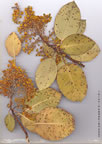| Ericaceae |
 Arbutus andrachne |
| Arbutus L. Arbutus andrachne L. Ömür: Çok yıllık Yapı: çalı Hayat formu: İlk çiçeklenme zamanı: 3 Son çiçeklenme zamanı: 5 Habitat: maki, Pinus brutia ormanları Minimum yükseklik: 0 Maksimum yükseklik: 800 Endemik: - Element: ? Türkiye dağılımı: Trakya, Dış Anadolu Genel dağılımı: Akdeniz Havzası, Kırım ve D. Karadeniz Kıyıları, Kıbrıs, B. Suriye ve Lübnan Bulunduğu kareler:A1 A2 A3 A5 A6 A7 A8 B1 C1 C2 C3 C5 C6 |
| A. andrachne L., Sp. Pl. ed. 2:566 (1762). Ic: Bot. Mag. 46: t. 2024 (1818); Sibth. & Sm, Fl. Graeca 4: t. 374 (1824). Map 10, p. 103. Similar to A. unedo, but bark red and coming off in large patches; glandular hairs on stem often inconspicuous; leaves ± spreading; petioles at least 1 cm; lamina broadly ovate, less than 2 x as long as broad, glaucous beneath, margin -usually entire; inflorescence a ± erect panicle with 6-10(-14) branches; pedicels to 9 mm, with glandular hairs; ovary often pubescent; fruit orange, papillae flattened horizontally, rather obscure. Fl. 3-5. Macchie, Pinus brutia forest, on igneous, serpentine and limestone substrata, s.1.-800 m. Described from the Orient. Turkey-in-Europe, Outer Anatolia, Islands. A1(E) Çanakkale: Soğanlı De. to Jam Baz De., Ingoldby 177. A1(A) Çanakkale: Renkoi (Erenköy), Dumbrek valley, Sini. 1883:255! A2(A) Bursa: 5 km E. of Gemlik, 150 m, D. 47787! A3 Zonguldak: 15 km from Devrek, 200 m, D. 37679! A5 Sinop: nr Deniz Kaya, 150 m, Tobey 103! A6 Amasya: Erbaa to Çatalan, 450 m, Tobey 713A! A7 Trabzon: nr Platina (Fortuna?) W. of Trabzon, 30 m, Balls 491! A8 Çoruh: Çoruh gorge between Artvin and Borçka, 500 m, D. 29859! B1 Izmir: between Barbaros and Mordoğan, A. & T. Baytop (ISTE 10721)! C1 Muğla: Karaova to Bodrum, 300 m, D. 40900! C2 Muğla: Marmaris to Emecik, 350 m, D. 25363! C3 Antalya: Yenice Kahve to Termessus, 700 m, D. 13938! C5 Içel: nr Mersin, Çukurova, Deaver T9! C6 Adana: Osmaniye, Nurdağ, 350-850 m, Toklu (ISTO 3130)! Is: Ikaria, 450-550 m, D. 40631! Samos, Fors.-Maj. 952; Kos, d'Urv.; Rodhos, Rech. 8544. E. Mediterranean area to Crimea and Sochi (E. Black Sea coast), Cyprus, W. Syria and Lebanon, with an outlier in N. Iraq. Most specimens are easily distinguished from A. unedo; the few doubtful specimens seen are aberrant forms of A. andrachne. Glandular hairs commonly occur at the beginning of each growth increment but are hard to observe; they are especially well developed in a specimen from C5 Adana (Gülek boğazi, 700 m, Coode & Jones 203!) which also has serrate leaves and is probably taken from an exceptionally vigorous shoot. H.Peşmen (unpubl. thesis) records the hybrid between A. unedo and A. andrachne, A. x andrachnoides Link, Enum. Hort. Berol. Alt. 1:395 (1821), from several localities in W. Anatolia: B1 Izmir, Mordoğan to Balikliova, s.l.-200 m, Peşmen 2027; C1 Aydin: Bafa G. to Söke, 150 m, Peşmen 635; C2 Muğla: d. Fethiye, between Göcek and Gökçeovacik köyü, 200 m, Regel & Peşmen 620. It flowers from Sept.-March. Yilmaz (ISTO 3537)! from A7 Trabzon: Maçka, is also possibly a hybrid, and there are further records from Is: Samos, Rech. 3479 & 3489; Lesvos, Cand. According to Fl. Europaea 3:11 (1972), the hybrid resembles A. andrachne in its bright red bark, but has at least some glandular hairs on the young twigs. A few plants of A. unedo flower in the spring and such plants could hybridize with the normally spring-flowering A. andrachne. |